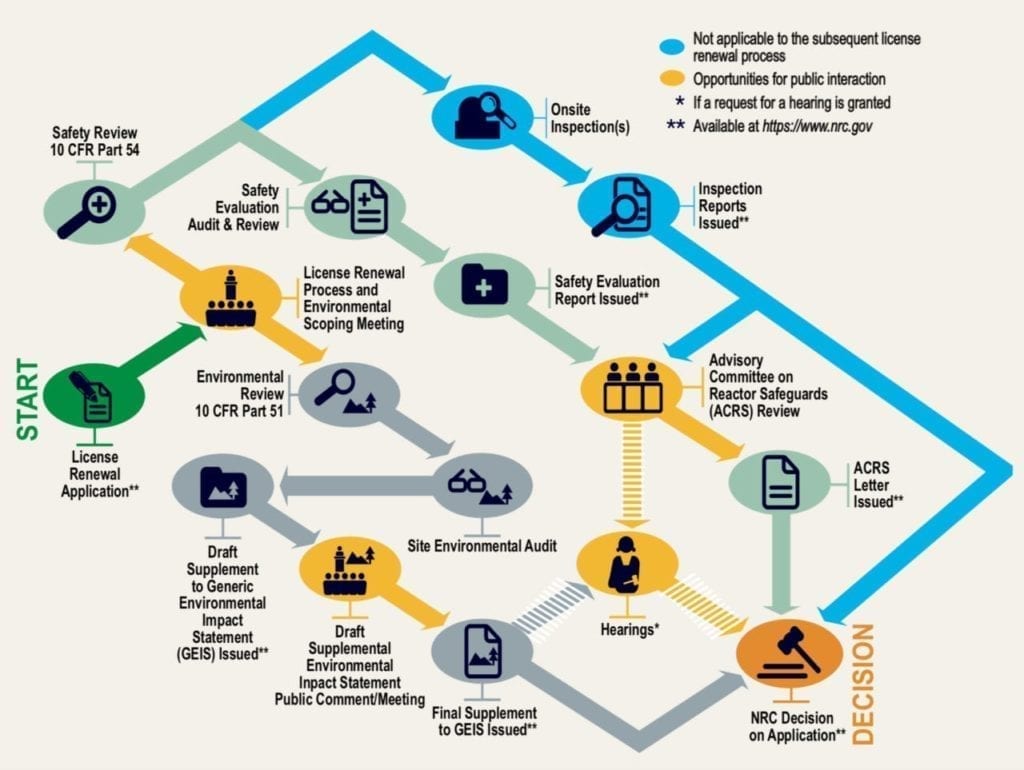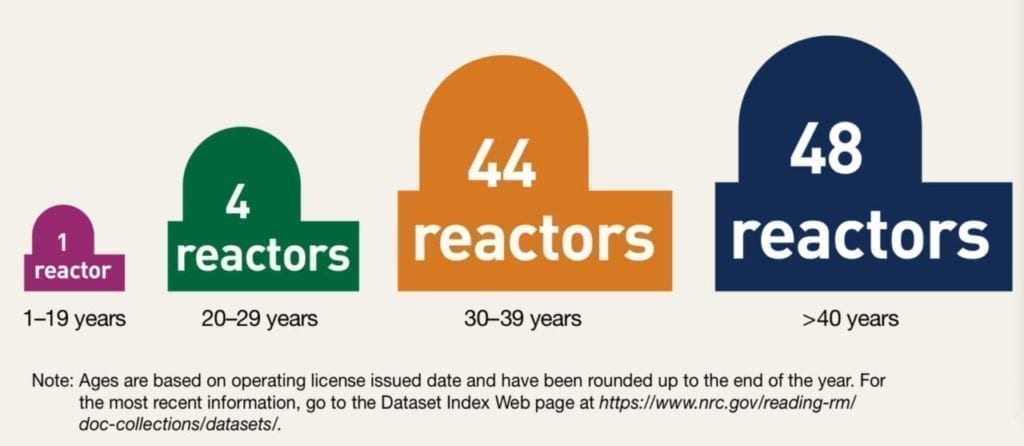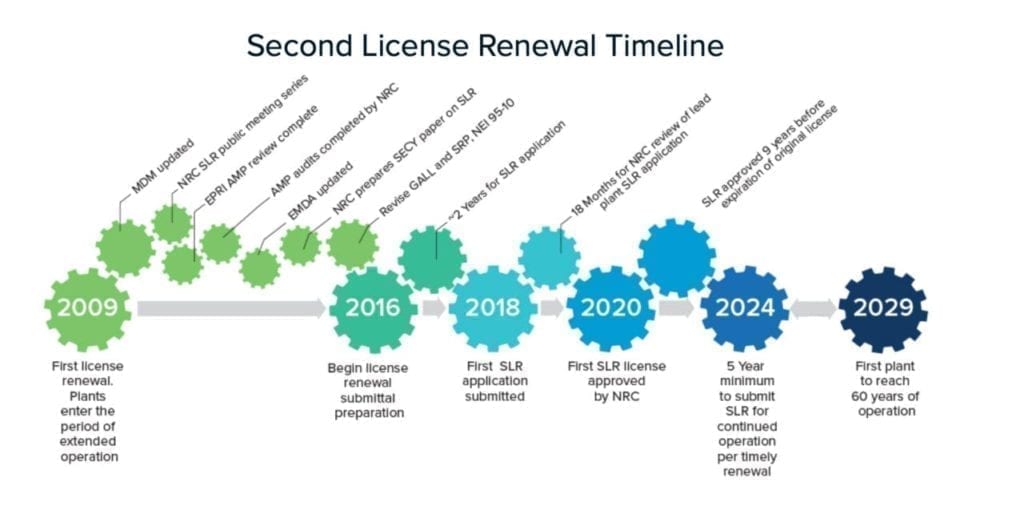NRC Issues First Subsequent License Renewals, Extends Nuclear Reactor Life to 80 Years
Marking a major milestone for the U.S. nuclear power sector, the Nuclear Regulatory Commission (NRC) has for the first time issued license renewals that authorize nuclear reactor operation beyond 60 years and up to 80 years.
The regulatory body on Dec. 5 issued subsequent license renewals (SLRs) for Units 3 and 4 at Florida Power & Light’s Turkey Point Nuclear Generating plant in Miami-Date County, effectively extending their lifetimes to 80 years.
For Unit 3, which began commercial operation in July 1972, the NRC-granted subsequent renewed license will expire on July 19, 2052, and for Unit 4, which began operation in April 1973, the license will now expire on April 10, 2053. The units’ previous licenses were set to expire in 2032 and 2033.
The two nuclear units are pressurized water reactors with three coolant loops built by Westinghouse Electric. Though Unit 3 is rated at 913 MW, and Unit 4 at 923 MWe, FPL noted in documents submitted to the NRC that onsite electrical power use amounts to slightly more than 100 MWe, leaving Units 3 and 4 with a net summer rating of 811 and 821 MWe—or a combined output of 1,632 MWe.
FPL applied for the first-of-their-kind licenses in January 2018, and the NRC granted the license extensions within roughly two years. As it does routinely in response to license renewal applications, staff issued a final Safety Evaluation Report this July, and a final Supplemental Environmental Impact Statement in October.
But the NRC’s Advisory Committee on Reactor Safeguards also reviewed the safety aspects of renewing the licenses, concluding in October that FPL’s programs and commitments to manage age-related degradation provided “reasonable assurance” that the units can be operated in accordance with its licensing basis for the 20-year extension, and without risk to health and safety to the public.

The Nation’s Nuclear Fleet Is Aging
The NRC notes that the average age of the nation’s 96 licensed nuclear units is about 39 years old. That has been of some concern to the nuclear industry, which has provided roughly a fifth of the nation’s power since the mid-90s. Owing to market conditions, technical issues, political pressure, and financial stresses, nine reactors have retired before their licenses expired since 2013, and an additional eight units are slated to retire by 2025.

The Nuclear Energy Institute (NEI) notes that half the nation’s nuclear fleet will need to obtain SLRs by 2040 to continue operating or be forced to retire. About 88 of the 96 reactors have already renewed their operating license once, extending their lifetimes from 40 to 60 years, but the majority of these will be “nearing the end of that 20-year extension by 2029 and will be seeking to renew their license a second time, for another 20-year period,” it says.
At least four other nuclear reactors are in the NRC’s review pipeline for SLRs: Exelon’s Peach Bottom Units 2 and 3, and Dominion’s Surry Units 1 and 2. The NRC in October completed a final safety evaluation report for the Peach Bottom units in October, and it will likely issue final renewal decision in March 2020. Dominion’s Surry application, in October also received a draft environmental impact statement, and the NRC’s final decision could come in June 2020. Dominion has also indicated it will submit an SLR application for North Anna Power Units 1 and 2 between October and December 2020. If these units are approved, it would allow at least a quarter of the nation’s fleet to operate beyond 2050, the Department of Energy (DOE) noted in November.

To help utilities prepare to make crucial decisions about whether to seek second licensing and support long-term operation of the nation’s reactors, the DOE established the Light Water Reactor Sustainability (LWRS) program in 2010. Backed by the Electric Power Research Institute (EPRI), that research identified key materials and parts used at the plants that could be affected with age, but it concluded that “Most of these materials met the desired performance standards expected for long-term operation. The materials that did show signs of normal aging and degradation were identified so that plants could proactively monitor and maintain them over time,” it said.
Age-Related Aches and Pains
According to the NRC, the most significant generic issues that nuclear plants could face if they operate beyond 60 years are: reactor pressure vessel embrittlement; irradiation-assisted stress corrosion cracking of reactor internals; concrete structures and containment degradation; and electrical cable environmental qualification, condition monitoring, and assessment.
“Each of these items has been addressed by FPL and evaluated by the staff through the review process,” it noted. FPL also completed improvements, upgrades, replacements, and modifications to numerous systems and components in preparation for life extension.
Of the bigger projects that FPL initiated since it applied for the license renewals, the company replaced reactor vessel heads, its main and auxiliary transformers, the cask crane structure and crane, high pressure turbine rotors, main condenser tube bundles and water boxes, turbine plant cooling water heat exchangers, and condensate pumps. FPL also rehabilitated a cooling canal and added two emergency diesel generators. Projects are still ongoing to replace low pressure turbine rotors, containment spray piping, and to modify the plant structure, NRC staff noted.
The Turkey Point site located south of Miami has three other units. Units 1 and 2 were formerly operated as natural gas and oil steam generating units but have since been repurposed in the synchronous condenser mode to support transmission reliability. Unit 5 is a natural gas-fired combined cycle plant.
—Sonal Patel is a POWER senior associate editor (@sonalcpatel, @POWERmagazine)